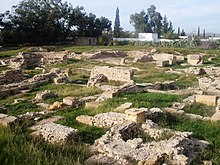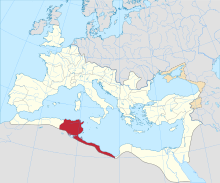Uppenna

Uppenna or Upenna is a Tunisian archaeological site located on the site of the present locality of Henchir Chigarnia. The site has delivered a basilica and the remains of a fortress .[1] [2]
Location
The site is located at Henchir Fraga at 36°10'20.60"N, 10°24'50.22"E about 8 km north of Enfidaville, Tunisia.[3]
Archaeology
A Christian baptistery was cleared by René Cagnat in 1881. The fortress, classified March 25, 1889,[4] was largely degraded thereafter. The discovery of 1881 was identified in 1901, by Paul Gauckler as belonging to a basilica, however, it is not exhaustively searched for budgetary reasons. The church may have been built atop the foundations of a demolished pagan temple.[5]
The site was considered important by the excavators of the campaigns in 1904–1905, and focusing on this building allowed the discovery of about forty mosaics, the main one is the mosaic of martyrs[6] which led to a major controversy between Gauckler and Dr. Louis Carton, recovering a conflict between the Antiquities Department and the Archaeological Society of Sousse. Indeed, the mosaic citing thirteen African martyred saints led to a debate on the place of the monument in the Donatist schism.
Bishopric

The Diocese of Uppenna, is an ancient episcopal seat of the Roman province of Byzacena.[7] The diocese was centered on a Roman town identifiable with Henchir-Medded in today's Tunisia.[dubious – discuss][8][9]
- Titular bishop Jan De Bie of Belgium.[10]
- Titular archbishop Sergio Obeso Rivera (1974 – 1979)
- Titular archbishop Bernardo José Bueno Miele (1967 – 1972)[11]
- Bishop Honorius,[12] is attested in the archaeology, and may be the bishop of the same name known from the synod called in 484 by Huneric, the Vandal.
- Bishop Baleriolus, known only from a mosaic in the basilica.
Basilica
Inscriptions in the church are dedicated to Bishops Honorius,[13] and Baleriolus, a deacon Crescentius and the Presbyter Emeritus.[14] Had an eight lobed font [15]
The basilica was built to memorialize a group of local martyrs. A Mosaic now housed in the Enfida Museum with a prominent Cross and the list of martyrs was uncovered in the basilica.[16]
Others commemorated in mosaics include Bishops Honorius[17] and Baleriolus, a deacon Crescentius and the Presbyter Emeritus.[18]
See also
External links
- This article incorporates text from a publication now in the public domain: Chisholm, Hugh, ed. (1911). "Enfidaville". Encyclopædia Britannica. Vol. 9 (11th ed.). Cambridge University Press. p. 403.
- Catholic Hierarchy
References
- ^ Jacques Alexandropoulos, Programme d'investigations archéologiques sur le site d'Uppenna, 1994.
- ^ Noël Duval, « L'Église d'Uppenna. Henchir Chigarnia, Tunisie », Bibliothèque des Écoles françaises d'Athènes et de Rome, 218bis, 1973, p. 87-106.
- ^ Henchir Chigarnia - Uppenna at Vici.org.
- ^ (in French) Dominique Raynal, Archéologie et histoire de L'Église d'Afrique. Uppenna I, éd. Presses universitaires du Mirail, Toulouse, 2006, p. 28
- ^ Anna Leone, The End of the Pagan City: Religion, Economy, and Urbanism in Late Antique North Africa (Oxford University Press. Oxford, 27 June 2013)p75.
- ^ J. Patout Burns, Robin M. Jensen, Christianity in Roman Africa: The Development of Its Practices and Beliefs (Wm. B. Eerdmans Publishing, 30 Nov. 2014).
- ^ Entry at www.catholic-hierarchy.org.
- ^ Duval Noël, L'évêque et la cathédrale en Afrique du Nord, in Actes du XIe congrès international d'archéologie chrétienne, École Française de Rome, 1989, p. 396.
- ^ J. Mesnage L'Afrique chrétienne, Paris 1912, pp. 46–48.
- ^ Titular Episcopal See of Uppenna.
- ^ Bernardo José Bueno Miele at Catholicheirachy.org.
- ^ J Burns and Robin Jensen, Christianity in Roman Africa (Wm. B. Eerdmans Publishing, 2014) p 125.
- ^ J Burns and Robin Jensen, Christianity in Roman Africa (Wm. B. Eerdmans Publishing, 2014) p 125.
- ^ J. Patout Burns, Robin M. Jensen, Christianity in Roman Africa: The Development of Its Practices and Beliefs (Wm. B. Eerdmans Publishing, 2014) p432.
- ^ J Burns and Robin Jensen, Christianity in Roman Africa (Wm. B. Eerdmans Publishing, 2014) p 109.
- ^ The local martyrs listed are, Saturninus Bindemius Saturninus Donatus Saturninus Gududa Paula Clara Lucilla Fortunatus Lader Cecillius ad Emilius.
- ^ J Burns and Robin Jensen, Christianity in Roman Africa (Wm. B. Eerdmans Publishing, 2014) p 125.
- ^ J. Patout Burns, Robin M. Jensen, Christianity in Roman Africa: The Development of Its Practices and Beliefs (Wm. B. Eerdmans Publishing, 2014) p432.
